Thiruvananthapuram International Airport
Thiruvananthapuram International Airport (IATA: TRV, ICAO: VOTV), is an international airport that serves Thiruvananthapuram, the capital city of Kerala, India. Established in 1932, it is the first airport in the state of Kerala and the fifth international airport of India, officially declared in 1991.[5] It is the operating base of Air India, Air India Express, IndiGo and SpiceJet. Spread over an area of 700 acres (280 ha), the airport is approximately 3.7 km (2.3 mi) due west from the city centre and the Padmanabhaswamy Temple,[5] 16 km (9.9 mi) from Kovalam beach, 13 km (8.1 mi) from Technopark and 21 km (13 mi) from the under-construction Vizhinjam International Seaport. It shares a visible proximity to Shankumugham Beach making it the nearest airport to a sea in India, just about 0.6 miles (approx. 1 km) away from the sea.
Thiruvananthapuram International Airport | |||||||||||
|---|---|---|---|---|---|---|---|---|---|---|---|
 | |||||||||||
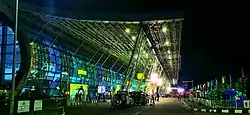 | |||||||||||
| Summary | |||||||||||
| Airport type | Public Private Partnership | ||||||||||
| Owner | Airports Authority of India | ||||||||||
| Operator | TRV (Kerala) International Airport Limited[1] | ||||||||||
| Serves | Thiruvananthapuram | ||||||||||
| Location | Chacka, Thiruvananthapuram, Kerala, India | ||||||||||
| Opened | 1932 | ||||||||||
| Hub for | Air India Express | ||||||||||
| Elevation AMSL | 4 m / 13 ft | ||||||||||
| Coordinates | 8.48°N 76.92°E | ||||||||||
| Website | Official website | ||||||||||
| Map | |||||||||||
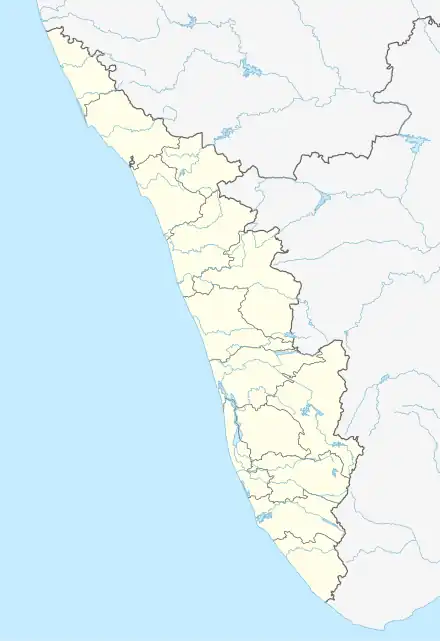 TRV  TRV  TRV | |||||||||||
| Runways | |||||||||||
| |||||||||||
| Statistics (April 2022 - March 2023) | |||||||||||
| |||||||||||
Thiruvananthapuram International airport is the eighth busiest airport in India in terms of international traffic[6] and the 15th overall in India till the month of August 2023. In the financial year 2022-23, the airport handled around 3.5 million passengers, with a total of around 25,000 aircraft movements.[7][8]
In addition to civil operations, the airport headquarters the Southern Air Command (India) of the Indian Air Force (IAF) and the Indian Coast Guard for their operations. IAF has an exclusive apron to handle all their operations. Thiruvananthapuram Airport also caters to the Rajiv Gandhi Academy for Aviation Technology which carries out pilot training activities.[9] The airport hosts Air India's Narrow body Maintenance, repair and overhaul unit – MRO consisting of twin hangars for servicing Boeing 737-type aircraft, servicing mostly Air India Express aircraft.
History
The airport was established in 1932 as part of the Royal Flying Club under the initiative of Lt. Col. Raja Goda Varman, husband of Karthika Thirunal Lakshmi Bayi, the Rani of Attingal and Travancore Kingdom.[10] Raja Goda Varman, a trained pilot, felt the need for an airport to accommodate Travancore in the aviation map of India and requested the Travancore Durbar to initiate the process of establishing an aerodrome. A detailed report was made and presented to the King by Consort Prince in this regard. It may be mentioned that the King was the brother of Lt. Col. Raja's wife, and the colonel's children were the heirs to the throne.
In 1935, on the royal patronage of Maharaja Chithira Thirunal, Tata Airlines made its maiden flight to the airport using DH.83 Fox Moth aircraft under command of India's first pilot Nevill Vintcent carrying Jamshed Navoroji, a Tata company official, and Kanchi Dwarakadas, commercial agent of Travancore in Karachi, with a special mail from the Viceroy of British India, Lord Willingdon, wishing birthday greetings to the Maharaja.[11]
The first flight took off on 1 November 1935, carrying mails of Royal Anchal (Travancore Post) to Bombay. In 1938, the Royal Government of Travancore acquired a Dakota as Maharaja's private aircraft and placed the first squadron of the Royal Indian Air Force (Travancore) for protection of the state from aerial attacks. After Independence, the airstrip was used for domestic flights with the construction of a new domestic terminal, Terminal 1.
International operations were initiated by Air India to cities in the Arabian Peninsula in the late 1970s using Boeing 707. By the early 80s, the then-Indian Airlines started service to Colombo, followed by service to Male. Later, Sri Lankan Airlines (then Air Lanka) and Air Maldives (now Maldivian) started operations. Followed by Indian Airlines, which started a service to Sharjah. On 1 January 1991, TIA was upgraded to an international airport, making it the fifth international airport of India after Delhi, Bombay, Madras and Calcutta.
On 1 March 2011, the first flight operated from the new international terminal, Terminal 2. IX 536 (Air India Express) from Sharjah marked the first arrival. Air India Express operated the first departure to Dubai from this new terminal. IndianOil Skytanking is the company that introduced single-man refuelling in India and started refuelling operations at Trivandrum in March 2016.
This was the main hub for the defunct Kairali Airlines from 9 January 2013 to 2017.
In November 2018, the Central Government cleared a proposal by the Airports Authority of India (AAI) for leasing out six of its airports, including Trivandrum. The following month, AAI commenced an international competitive bidding process to award Operations, Management and Development (OMD) contracts for the six airports.[12] The Adani Group, GMR Group and Kerala State Industrial Development Corporation (KSIDC) participated in the bidding process which was won by the Adani Group.[13]
Since some public interest litigations were filed concerning the bidding process for the airport, the Union Cabinet gave its approval for awarding the airport to Adani subject to the outcome of Writ Petition. Accordingly, AAI signed a letter of agreement with Adani in September 2020.[14] Adani Thiruvananthapuram International Airport Limited (ATIAL), floated by the Adani Group to run the airport, would operate, manage and develop the airport for fifty years.[15] As per the agreement, ATIAL would get control of the airport only after a concession agreement was executed and the performance bank guarantee was paid and subject to clearance of legal hurdles.[16]
Facilities
Runway

Thiruvananthapuram International Airport has a single 3,050 m (10,010 ft)-long runway,[17] equipped to operate any type of aircraft. It has a 1,880 m (6,170 ft)-long parallel taxiway.[18]
Terminal

There are two terminals. Terminal 1 is for domestic flights (except Air India), and Terminal 2 is for all international flights as well as all domestic flights of Air India.
The international terminal ground operations are handled by Air India SATS Airport Services Pvt. Ltd. It is fully air-conditioned with a WiFi facility. The terminal features spacious lounges, natural lighting with extensive use of glass roofing and better conveyance facilities for passengers. It has three baggage carousels and elaborate immigration/customs facilities. Flemingo, India's first privately owned duty-free operator is managing the duty-free shop at the international terminal.
The domestic terminal has basic amenities including cafés, a beer and wine bar, a book-seller, free local calls, a Specialized baby care room and phone-recharging points.[19] Into Plane Services fuelling operations handled by IndianOil Skytanking.
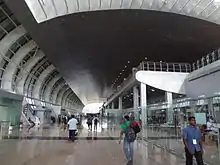
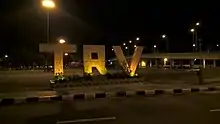

Terminal 1 (Domestic)
The domestic terminal was the first terminal of the airport inaugurated by Chief minister of Kerala EK Nayanar in 1992. It has an area of 9,200 m2 (99,000 sq ft) and can handle 400 passengers at a time.[20] The terminal has two Aerobridges and two remote gates. All airlines except Air India are served by the domestic terminal.
Terminal 2 (International)
The newly built Terminal 2 has three additional jetways and parking bays to accommodate 8 aircraft. The terminal is built opposite to the current terminal across the runway and is closer to the city side. The terminal, constructed by the AAI and designed by the UK firm, Pascall+Watson Architects, is expected to provide impetus to the development of the IT sector and the tourism industry in the southern districts of Kerala.
The international terminal covers an area of 35,000 m2 (380,000 sq ft). It can handle the passengers of three Airbus A340s and one Boeing 747 aircraft simultaneously (roughly 1500 passengers).[21] The annual handling capacity of the terminal will be 1.8 million.
The check-in area has a floor area of 950 m2 (10,200 sq ft) and an arrival area of 600 m2 (6,500 sq ft). To enable the passengers to check in at any counter, a Common Users Terminal Equipment (CUTE) is installed. X-ray machines are attached to the side of the conveyor belts for faster clearance of baggage.
The entrance to the terminal is from Chacka-Eenchakkal Road. A bridge has been built across the Parvathy Puthanar canal to link the new terminal to the Kazhakuttam-Inchivila NH (National Highway) 47 bypass.[18] The new terminal has a car park area that can accommodate about 600 cars.
There is a pre-paid taxi service counter and foreign exchange (Thomas Cook India) counter in the arrivals area.[18]
Thiruvananthapuram Airport was included in the Ministry of civil aviation strategic plan for 2010–2015 to upgrade as a Category-A airport by developing to aerodrome CODE 4E/4F, constructing a parallel runway with taxiways alongside both runways and so forth.
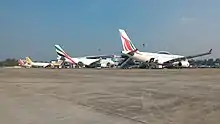
Air traffic control
The air traffic control (ATC) tower is 18 m (59 ft) tall. There are plans to build a new 50 m (160 ft) tall ATC tower for Thiruvananthapuram Airport near the new international terminal. The airport has a CAT-1 instrument landing system (ILS), DVOR and distance measuring equipment (DME). The airport is also equipped with a Mono-pulse Secondary Surveillance Radar, Air Route Surveillance Radar and an Airport Surveillance Radar which allows approach and area control of the airspace around the airport and nearby air routes.[22][23]
MRO facility
Thiruvananthapuram International Airport hosts Air India's Narrow body Maintenance, repair and overhaul unit—MRO consisting of twin hangars for servicing Boeing 737 type aircraft, servicing mostly Air India Express aircraft. The Maintenance Repair Overhaul is set up on 6.07 hectares (15.0 acres) of land at a cost of Rs. 110 crores it was commissioned on 16 December 2011. The maintenance of two aircraft can be simultaneously done at the two hangars present at the MRO. The facility is state-of-the-art with 5,000 sq ft (460 m2) of workshop, 10,000 sq ft (930 m2) apron, electrically operated and vertically moving hangar door system, warehouse and office space. The Maintenance, Repair, and Overhaul (MRO) facility of Air India Charters Limited (AICL) at Thiruvananthapuram International Airport was given permission to carry out the crucial ‘C’ checks of their Boeing 737-800 fleet.[24][25]
Other operations
In addition to civil operations, Thiruvananthapuram Airport also caters to IAF and Coast Guard for their strategical operations and Airforce NCC Cadets' Trg . IAF have an exclusive apron to handle all their operations. Thiruvananthapuram Airport also caters for Rajiv Gandhi Academy for Aviation Technology. The academy has its own hangar facility at the airport. The hangar facility can accommodate 10 trainer aircraft.[26]
Expansion
Further expansion of the airport has been planned with the AAI demanding 82 acres for the demolition of the existing domestic terminal and the construction of a newer one and other related facilities for Thiruvananthapuram Airport. The state government has agreed to acquire 18 acres for the construction of the domestic terminal. The AAI is planning to construct a new terminal of around 40,000 square metres, which would spruce up the city airport's total terminal area to 75,000-square-metres. Paper works, including drawing of plans, for the new terminal building have already begun at the AAI headquarters. The plan is to complete the construction of the new terminal within 18 to 24 months after the state government hands over the land to the Airport Authority of India. The elevation of new terminal would be identical to the existing Terminal 2.[27]
Airlines and destinations
| Airlines | Destinations |
|---|---|
| Air Arabia | Abu Dhabi,[28] Sharjah |
| Air India | Delhi, Mumbai[29][30] |
| Air India Express | Abu Dhabi, Bahrain, Bangalore (begins 20 November 2023),[31] Dammam, Doha, Dubai–International, Kozhikode, Muscat, Salalah, Sharjah[29] |
| Emirates | Dubai–International[32] |
| Etihad Airways | Abu Dhabi (resumes 1 January 2024)[33] |
| Gulf Air | Bahrain[34] |
| IndiGo | Ahmedabad, Bangalore, Chennai, Delhi, Hyderabad, Kannur, Kochi, Kolkata, Mumbai, Nagpur, Pune, Sharjah |
| Kuwait Airways | Kuwait City[35] |
| Malaysia Airlines | Kuala Lumpur–International (begins 10 November 2023)[36] |
| Maldivian | Malé Seasonal: Hanimaadhoo[37] |
| Oman Air | Muscat[38] |
| Qatar Airways | Doha[39] |
| Scoot | Singapore[40] |
| SpiceJet | Bangalore |
| SriLankan Airlines | Colombo–Bandaranaike[41] |
| Vistara[42] | Delhi,[43] Mumbai |
Security
Thiruvananthapuram International Airport is listed among the major airports of India. Its safety and security are handled by the Bureau of Civil Aviation Security through the Central Industrial Security Force#Airport Security (CISF). In the past, airport security was under the control of airport police (under the state government). However, following the hijacking of Indian Airlines Flight 814 in 1999, airport security was handed over to CISF. Thiruvananthapuram Airport also has advanced security equipment including X-RAY Baggage inspection (X-BIS), Explosive Trace Detection System (ETDS) and provision of an In-Line Baggage Screening system; at the NITB, state-of-the-art Closed Circuit Television (CCTV), Flight Information Display System (fids) and Public Address (PA) systems, as well as an Interactive Voice Response System (IVRS) for flight information, are there for passengers' convenience.[26]
The In-Line Baggage Screening system (ILBS) was installed at Terminal 2 on 21 July 2020.
See also
References
- "TRV (Kerala) International Airport". cbonds.com. Retrieved 7 March 2023.
- "Annexure III – Passenger Data" (PDF). aai.aero. Retrieved 22 April 2023.
- "Annexure II – Aircraft Movement Data" (PDF). aai.aero. Retrieved 22 April 2023.
- "Annexure IV – Freight Movement Data" (PDF). aai.aero. Retrieved 22 April 2023.
- "Thiruvananathapuram". Airports Authority of India. Archived from the original on 25 November 2010.
{{cite web}}: CS1 maint: unfit URL (link) - "Cial Retains Spot As Third-busiest Airport". The Times of India. 31 January 2022. Retrieved 22 February 2022.
- "Annexure III – Passenger Data" (PDF). aai.aero. Retrieved 22 April 2023.
- "Annexure II – Aircraft Movement Data" (PDF). aai.aero. Retrieved 22 April 2023.
- "Rajiv Gandhi Academy For Aviation Technology - Thiruvananthapuram". Rajiv Gandhi Academy For Aviation Technology. 13 July 2018. Archived from the original on 17 July 2017. Retrieved 10 December 2019.
- "Trivandrum International Airport". Airport Technology. Verdict Media Ltd. Archived from the original on 12 November 2010. Retrieved 1 March 2011.
- "Kerala celebrates 75th anniversary of civil aviation". The Hindu. Chennai, India. 29 October 2010. Archived from the original on 30 November 2010. Retrieved 1 March 2011.
- "AAI seeks bids for six airports, to finalise bidders on February 28". The Economic Times. 17 December 2018. Retrieved 18 September 2020.
- "Adani Group bids highest to operate Trivandrum International Airport". The Times of India. 25 February 2019. Retrieved 18 September 2020.
- "AAI, Adani Group sign letter of agreement for Thiruvananthapuram, Guwahati, Jaipur airports". CNBC-TV18. 11 September 2020. Retrieved 18 September 2020.
- "Hardeep Puri lays down 'facts' after Kerala urges Centre to reconsider Trivandrum airport privatisation - Times of India". The Times of India. 20 August 2020. Retrieved 20 August 2020.
- "LOA for Thiruvananthapuram airport issued to Adani Group". The Hindu. 11 September 2020. Retrieved 18 September 2020.
- "About Us | Thiruvananthapuram International Airport". www.adani.com. Retrieved 8 February 2022.
- Radhakrishnan, S. Anil (12 February 2011). "Terminal may put development on fast track". The Hindu. Archived from the original on 1 March 2011.
- "Airport Lounge". SilkAir. Archived from the original on 24 February 2011. Retrieved 1 March 2011.
- "THIRUVANANATHAPURAM". Airports Authority of India. 26 August 2014. Archived from the original on 2 September 2017. Retrieved 5 May 2014.
- "World class terminal for Thiruvananthapuram International Airport". The Hindu. Thehindu.com. 16 October 2009. Archived from the original on 3 September 2011. Retrieved 27 December 2018.
- "Trivandrum International Airport" (PDF). Airports Authority of India. Archived from the original (PDF) on 6 December 2017. Retrieved 6 December 2017.
- "New upgraded radar at Thiruvananthapuram airport". The Hindu. 18 September 2013. Archived from the original on 6 December 2017. Retrieved 6 December 2017.
- "Air India's MRO Facility at Thiruvananthapuram Commissioning Today". Some Updates from Thiruvananthapuram. 16 December 2011. Archived from the original on 9 July 2018. Retrieved 27 December 2018.
- Radhakrishnan, S. Anil (16 December 2011). "Air India's MRO unit to be opened today". The Hindu. ISSN 0971-751X. Archived from the original on 15 February 2020. Retrieved 15 February 2020.
- Mehta, Devinder C. (March 2011). "Trivandrum Airport Gets an Impressive International Terminal" (PDF). Airports International Indian Edition. 3 (5): 8–11. Archived from the original (PDF) on 29 March 2017.
- Raghunath, Arjun (23 July 2016). "New terminal for Thiruvananthapuram airport". Deccan Chronicle. Archived from the original on 15 December 2018. Retrieved 27 December 2018.
- "Destinations". Air Arabia. Retrieved 3 February 2022.
- "Airlines INTL Schedule". Retrieved 30 March 2022.
- "Airlines DOM Schedule". Retrieved 30 March 2022.
- "Air India Express to commence Bangalore-Thiruvananthapuram service in Nov-2023". CAPA. Retrieved 11 October 2023.
- "Thiruvananthapuram". Emirates. Retrieved 3 February 2022.
- "Etihad NW23 Network Changes – 09AUG23". Aeroroutes. Retrieved 10 August 2023.
- "Trivandrum". Gulf Air. Retrieved 3 February 2022.
- "Indian Sub-continent Flights". Kuwait Airways. Retrieved 1 February 2022.
- "MALAYSIA AIRLINES FURTHER EXPANDS INDIA NETWORK IN NW23". Aeroroutes. Retrieved 2 September 2023.
- "Maldivian Adds Colombo Ratmalana Service in Mid-1H22". Aeroroutes. Retrieved 28 March 2022.
- Khan, Faiz (4 September 2023). "Oman Air and Salam Air Launches New Flights to Kerala". Aviation A2Z. Retrieved 5 September 2023.
- "Trivandrum,India". Qatar Airways. Retrieved 3 February 2022.
- "Destinations Map". Scoot. Retrieved 3 February 2022.
- "Route Map". SriLankan Airlines. Retrieved 2 February 2022.
- "Vistara Flight Schedule". Retrieved 29 May 2023.
- "Vistara announces daily direct flights between Delhi, Thiruvananthapuram; check fares, schedule". 16 October 2019. Archived from the original on 25 January 2020. Retrieved 10 December 2019.
External links
![]() Media related to Trivandrum International Airport at Wikimedia Commons
Media related to Trivandrum International Airport at Wikimedia Commons